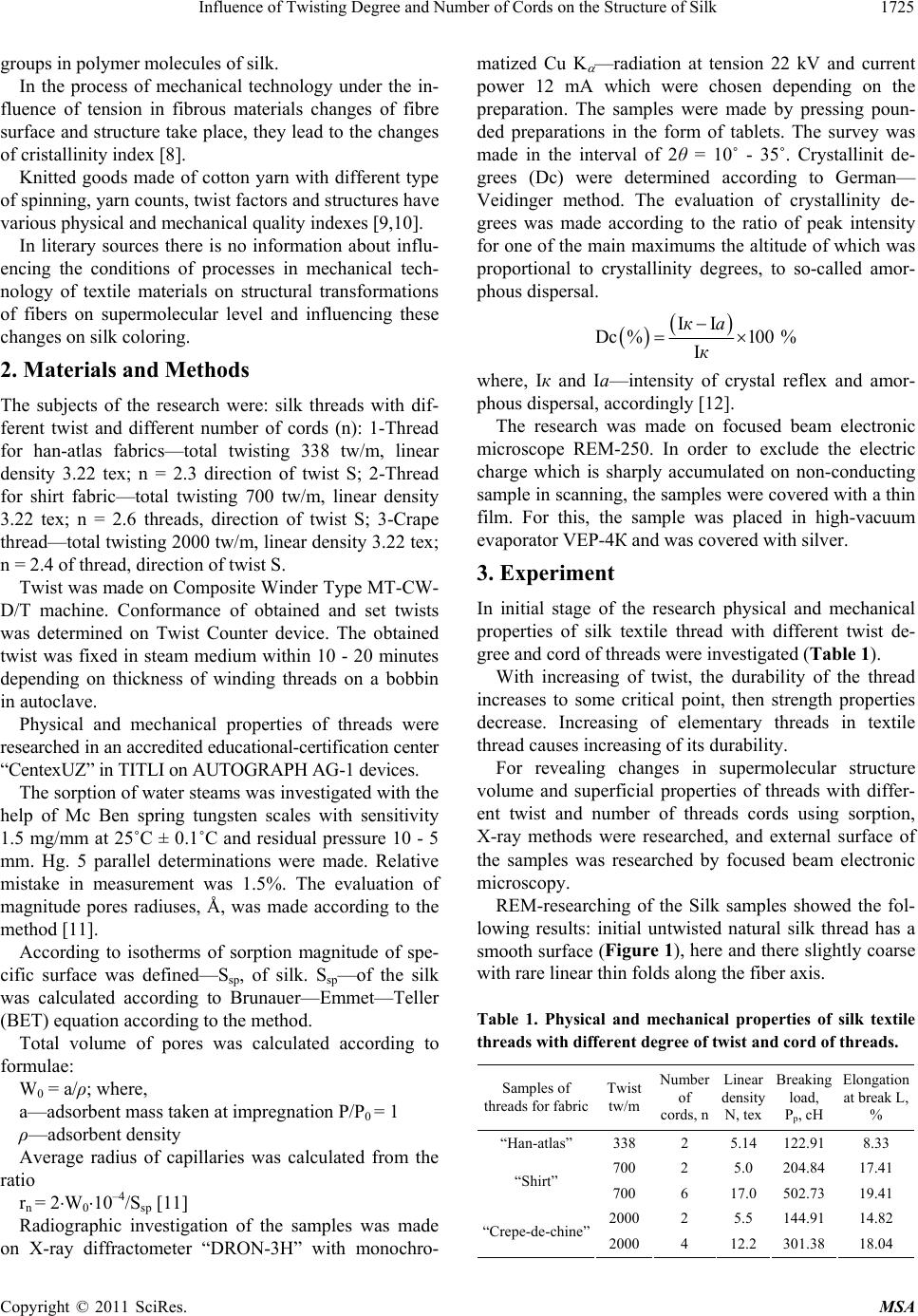
Influence of Twisting Degree and Number of Cords on the Structure of Silk 1725
groups in polymer molecules of silk.
In the process of mechanical technology under the in-
fluence of tension in fibrous materials changes of fibre
surface and structure take place, they lead to the changes
of cristallinity index [8].
Knitted goods made of cotton yarn with different type
of spinning, yarn counts, twist factors and structures have
various physical and mechanical quality indexes [9,10].
In literary sources there is no information about influ-
encing the conditions of processes in mechanical tech-
nology of textile materials on structural transformations
of fibers on supermolecular level and influencing these
changes on silk coloring.
2. Materials and Methods
The subjects of the research were: silk threads with dif-
ferent twist and different number of cords (n): 1-Thread
for han-atlas fabrics—total twisting 338 tw/m, linear
density 3.22 tex; n = 2.3 direction of twist S; 2-Thread
for shirt fabric—total twisting 700 tw/m, linear density
3.22 tex; n = 2.6 threads, direction of twist S; 3-Crape
thread—total twisting 2000 tw/m, linear density 3.22 tex;
n = 2.4 of thread, direction of twist S.
Twist was made on Composite Winder Type MT-CW-
D/T machine. Conformance of obtained and set twists
was determined on Twist Counter device. The obtained
twist was fixed in steam medium within 10 - 20 minutes
depending on thickness of winding threads on a bobbin
in autoclave.
Physical and mechanical properties of threads were
researched in an accredited educational-certification center
“CentexUZ” in TITLI on AUTOGRAPH AG-1 devices.
The sorption of water steams was investigated with the
help of Mc Ben spring tungsten scales with sensitivity
1.5 mg/mm at 25˚C ± 0.1˚C and residual pressure 10 - 5
mm. Hg. 5 parallel determinations were made. Relative
mistake in measurement was 1.5%. The evaluation of
magnitude pores radiuses, Å, was made according to the
method [11].
According to isotherms of sorption magnitude of spe-
cific surface was defined—Ssp, of silk. Ssp—of the silk
was calculated according to Brunauer—Emmet—Teller
(BET) equation according to the method.
Total volume of pores was calculated according to
formulae:
W0 = a/ρ; where,
a—adsorbent mass taken at impregnation Р/P0 = 1
ρ—adsorbent density
Average radius of capillaries was calculated from the
ratio
rn = 2W010–4/Ssp [11]
Radiographic investigation of the samples was made
on X-ray diffractometer “DRON-3Н” with monochro-
matized Cu K
—radiation at tension 22 kV and current
power 12 mА which were chosen depending on the
preparation. The samples were made by pressing poun-
ded preparations in the form of tablets. The survey was
made in the interval of 2θ = 10˚ - 35˚. Crystallinit de-
grees (Dc) were determined according to German—
Veidinger method. The evaluation of crystallinity de-
grees was made according to the ratio of peak intensity
for one of the main maximums the altitude of which was
proportional to crystallinity degrees, to so-called amor-
phous dispersal.
II
Dc%100 %
I
ка
к
where, Iк and Iа—intensity of crystal reflex and amor-
phous dispersal, accordingly [12].
The research was made on focused beam electronic
microscope REM-250. In order to exclude the electric
charge which is sharply accumulated on non-conducting
sample in scanning, the samples were covered with a thin
film. For this, the sample was placed in high-vacuum
evaporator VEP-4К and was covered with silver.
3. Experiment
In initial stage of the research physical and mechanical
properties of silk textile thread with different twist de-
gree and cord of threads were investigated (Table 1).
With increasing of twist, the durability of the thread
increases to some critical point, then strength properties
decrease. Increasing of elementary threads in textile
thread causes increasing of its durability.
For revealing changes in supermolecular structure
volume and superficial properties of threads with differ-
ent twist and number of threads cords using sorption,
X-ray methods were researched, and external surface of
the samples was researched by focused beam electronic
microscopy.
REM-researching of the Silk samples showed the fol-
lowing results: initial untwisted natural silk thread has a
smooth surface (Figure 1), here and there slightly coarse
with rare linear thin folds along the fiber axis.
Table 1. Physical and mechanical properties of silk textile
threads with different degree of twist and cord of threads.
Samples of
threads for fabric
Twist
tw/m
Number
of
cords, n
Linear
density
N, tex
Breaking
load,
Рр, cН
Elongation
at break L,
%
“Han-atlas” 338 2 5.14 122.91 8.33
700 2 5.0 204.84 17.41
“Shirt” 700 6 17.0 502.73 19.41
20002 5.5 144.91 14.82
“Crepe-de-chine” 20004 12.2 301.38 18.04
Copyright © 2011 SciRes. MSA